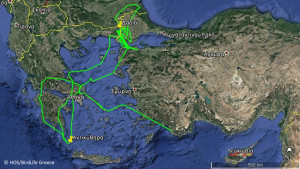The Eleonora’s falcons nest on the islands and the rocky islets of the Aegean Sea in August, later than any other bird in our country, as, when the chicks are hatched (end of August – early September), there is plenty of food in the Aegean thanks to the millions of migratory birds returning to Africa. But what about the period before autumn migration, when food is scarce in the Aegean and the rocky islands are burned under the summer sun? It’s simple: the Eleonora’s falcon travels in the hinterland looking for areas rich in large insects, with consist its food. The great hunter of the Aegean, the rest of the year is mainly insectivorous!
Two female Eleonora’s falcon that will nest in the cliffs of Antikythera Island in a month are being watched by LIFE ElClimA’s group of ornithologists since last autumn. They record their routes using small satellite transmitters that are mounted on their backs. The purpose of the research is the identification of the areas that the species uses as feeding places before the breeding season. While this habit of the species has been known to the ornithologists for many years, it is the first time in Greece that the movements of Eleonora’s falcon during the pre-reproduction period are monitored using the most modern technology. As it is expected, the wandering of such a good traveler (Eleonora’s falcon overwinters in Madagascar) offers intense emotions to anyone who is lucky to watch it, even in a computer screen. The ability of the Eleonora’s falcons to travel long distances in a short time, to travel and chase at night, but also to return precisely to the cliffs that were born, is truly admirable. To get an idea of their impressive skills, let’s follow the two female falcons on their flights.
ELEF02 (Plagara)
At dawn on May 7, Plagara arrived in the Aegean and followed a rout that included several islands that host small or large colonies of the Eleonora’s falcon (Fournoi, Ikaria, Mykonos, Tinos, Andros and Euboea). Her wandering continued in the Dirfi Mountain in Euboea where she fed for some days in the forests. In the following days, she turned to the hills of the hinterland to get to Karpenissi. From there, Plagara turned south. She departed before dawn (at about 3:00) and after crossing the entire western Peloponnese, she arrived at the peninsula of Mani. Her infallible instinct led her, like every year, to her birthplace, the island of Antikythera. Plagara roosted at the same place where she made her nest last year, under the tallest peak of the island that she was named after. After a brief inspection, and probably domination of the spot (the Eleonora’s falcons are nesting in colonies and so there is enough competition for the nests), she departed again on May 19, heading north.
At the end of the first day she had already crossed the whole Peloponnese, passing over Kythera Island, Elafonisos, Mount Parnonas, Nafplio and Epidavros. The next day through Attica, Boeotia and Euboea, she arrived in southern Pelion. After a short break, at midnight, she went east to the Aegean Sea and after passing over the National Marine Park of Northern Sporades, Lemnos and Samothraki Islands, she arrived after 12 hours of continuous flight in the plain of Komotini. As it was seen from the following days’ routes, Plagara’s goal was the forests of the region, including the famous forest of Dadia and the Evros Delta, between which she spent long distances daily to find food. However, as birds know no borders, the excursions of Plagara were extended to the plain of Adrianople, to the Standzha park in southern Bulgaria and to the Dardanelle Straits, where she gradually moved the “center” of her movements during June.
Only in May, Plagara, according to the signals that sent us, traveled 6,500 kilometers. In fact, however, she flied much more, since the spots are taken every 2 hours, and a straight line is calculated between them.
Travelling of Plagara

 Ελληνικά
Ελληνικά English
English